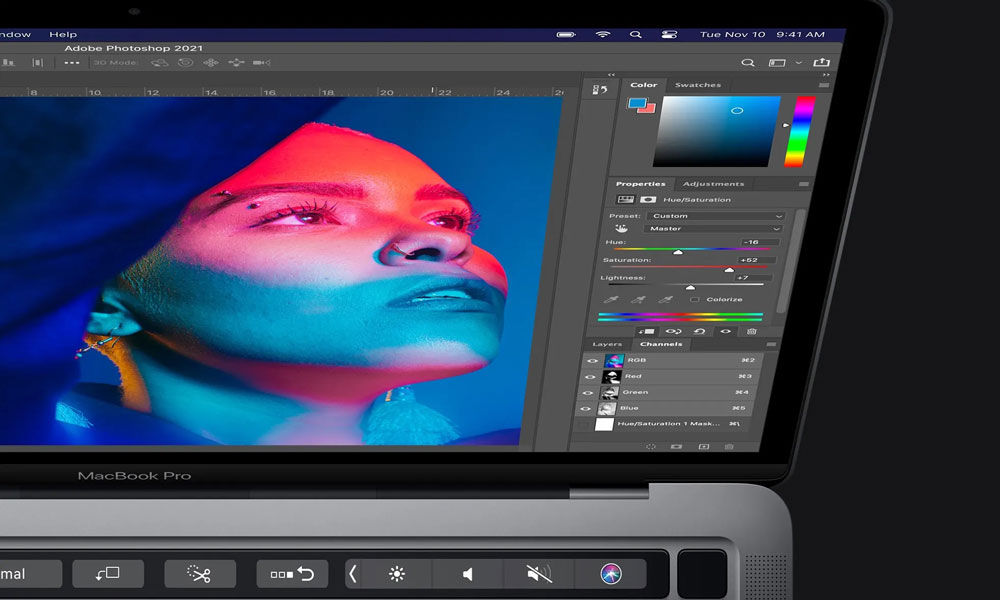Adobe Photoshop Is Finally Ready for Apple Silicon with One Amazing New Feature
 Credit: Adobe
Credit: Adobe
Toggle Dark Mode
For many creative professionals, Apple’s transition to the M1 chip last fall felt a bit incomplete, since even though many developers were quick to port their apps over to the new Apple Silicon platform, there was at least one pretty big-name straggler: Adobe’s Photoshop.
To be fair, Adobe was fairly quick to give Lightroom the full M1 treatment — something that Apple actually highlighted during its November launch event — the best the company seemed to be able to do with its flagship Photoshop product was release a very anemic beta with native Apple Silicon support.
Although Apple announced that an M1-compatible version of Photoshop was expected by early this year, the glaring omissions in the early M1 beta made a lot of us wonder if that was actually going to happen. Serious features like content-aware fill, scale, and move were missing, along with the patch tool, and the healing and spot healing brushes, to name just a few. There was also no RAW camera support either.
Further, despite the insanely fast overall performance of Apple’s Silicon, Adobe had to admit that there were some features that were actually slower on M1 Macs than on the Intel version. To add insult to injury, Adobe had also made it clear that it was not offering any official support for those trying to run the Intel versions of those apps on M1 Macs via Rosetta 2.
Photoshop for M1
Taken together, this diminished the hopes of many that Adobe would have a full-featured M1 native version of Photoshop ready anytime soon. The good news, however, is that Adobe has clearly been very hard at work getting it ready, and they’ve come a long way in a relatively short time when it comes to porting those features over.
The result is that as of this week, Adobe Photoshop is officially ready for Apple Silicon, and although there still appear to be a few things missing, those seem to be confined to only the very newest features that Adobe recently added to its Intel version of Photoshop.
For example, Adobe notes that features like Invite to Edit Cloud Documents and Preset Syncing are both absent in this first M1 native version, although these were added so recently that it’s hard to consider them a serious omission — most Photoshop users probably haven’t started relying on them yet.
More to the point, however, Adobe adds that they will be coming soon. The company simply felt that it was more important to get the M1 native version out as quickly as possible rather than holding back the release “while the team wraps up work on these last few features.”
Further, anybody who truly needs them can simply continue running the Intel version through Rosetta 2 until they get added to the official M1 build.
Most importantly, Adobe promises that the native M1 version of Photoshop should be noticeably faster on Apple Silicon Macs than the one that came before, with tests showing “a wide range of features running an average of 1.5X the speed of similarly configured previous generation systems,” while certain “compute-heavy operations” like Content-Aware Fill and Select Subject are substantially faster with Apple’s new architecture.
So far, our own experience with the new version also bears this out, with the native M1 Photoshop loading faster and just feeling generally much zipper on our M1 MacBook Pro than the Intel version, which always felt a little bit like wading through mud compared to all of our M1 native apps.
However, Adobe is also making it clear that this is just its first kick at the can, and it plans to continue working with Apple to optimize performance even further over time.
What’s New? Super Resolution
Thanks to the power of the M1 chip, Adobe has also been able to sneak an entirely new feature into the mix, taking advantage of the Neural Engine and advanced machine learning to allow users to increase the resolution of photos with a single click.
Imagine turning a 10-megapixel photo into a 40-megapixel photo with one click that produces very high-quality results. Today, we release the new Super Resolution feature in the Adobe Camera Raw plugin in Photoshop, which does just that.
Adobe
Adobe also promises that this will soon be making its way to both Lightroom and Lightroom Classic. For a deeper dive into how it all works, Adobe’s lead imaging scientist, Eric Chan, has shared a blog post with all the details of the science and technology behind it.
Photoshop for iPad
Adobe is also pushing out an update to Photoshop for iPad today that adds improvements to Cloud Documents, including the ability to work offline and access version history right from the iPad.
Both features have been available in Photoshop on the desktop for some time, but considering its more mobile nature, offline documents should especially be a considerable boon for iPad users, especially those with Wi-Fi only models. Unfortunately, it doesn’t appear to make any automatic decisions as to which documents should be available offline, so you’ll still need to plan ahead by tagging any work that you want to take with you on the go.
Version history is also a nice enhancement, as it will allow users to more easily revert to previous document versions without leaving the app. While this was possible before, it required a separate visit to your account on Adobe’s Creative Cloud site using Safari.






